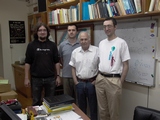The experiment was inaugurated in 2006, when the first "normal" muon-neutrinos were detected after a trip of 730 km from CERN, covered in about 2.4 milliseconds, at the speed of light. After then, a careful and tireless search started to find the tiny and very special signal induced by a tau-neutrino.
OPERA accomplishes its neutrino detection task with its "heart" made of more than 150000 small units called "bricks" (for a total mass of 1300 tons) each of them equivalent to a sophisticated photographic camera. Thanks to these bricks, made of a sandwich of lead plates and special photographic films, the OPERA researchers can detect all details of the "neutrino events" by accurately measuring the elementary particles produced in the interaction of the neutrino with the brick.
OPERA has been designed, realized and being conducted by a large team of researchers from all over the world: Belgium, Croatia, France, Germany, Israel, Italy, Japan, Korea, Russia, Switzerland, Tunisia and Turkey.
The computer display of the first tau-neutrino candidate event is shown below. One can see a detail of the region around the point of interaction of the neutrino (coming from the left of the figure) producing several particles identified by their tracks in the brick. The detection of the track with a "kink" is the likely signature of a tau-neutrino interaction, with a probability of about 98%. The picture describes a volume of only a few cubic millimetres, but rich of valuable information for the OPERA physicists.
This is a crucial milestone for neutrino physics made possible by a complex scientific enterprise that has been realized thanks to the skill of a large number of scientists, engineers, technicians and students, and with the strong commitment of the various actors of the project. In particular, we mention the host laboratories LNGS/INFN and CERN, together with the major financial support of Italy and Japan, and with substantial contributions from Belgium, France, Germany and Switzerland.
Since the year 2000 Dr. Ante Ljubicic, Dr. Mario Stipčević and Dr. Kresimir Jakovcic, colleagues in the Laboratory for electromagnetic and weak interactions at the RBI have participated from conception to realization in the OPERA experiment carried out at CERN. Three years ago the group was joined by graduate student Budimir Klicek who had completed his diploma work in this field. This group worked on all phases of construction, testing and installation of innovative particle detectors RPC and GRPC. In addition they provided several software applications used to monitor the experiment and analyse the collected data. This greatly improved the work of the collaborators and the attained results. From time to time up to 10 graduate and undergraduate students worked on the project and gained valuable experience in the work of large international experiments. It should be emphasized that the researchers in this RBI laboratory have over twenty years of experience in the field of neutrino oscillations which began with the cofounding of the NOMAD experiment at CERN in 1991.
Currently the OPERA collaboration involves about 170 scientists at 33 institutions from 12 countries including the Ruđer Bošković Institute.


